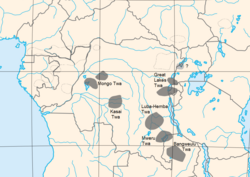
Bangweulu Twa, or the BaTwa of the Bangweulu swamps, are one of several groups of Twa living in Zambia. [1] Others are Kafwe Twa and Lukanga Twa. They are also known by the names BaTwa [2] or Abatwa. [3] While other Twa groups that are scattered across equatorial Africa are described as pygmy groups and averaging about 1.5 m (4 ft 11 in) in height, the Bangweulu Twa are described as taller and at least partly of Bantu origin [4] [5] but they may be the descendants of former hunter-gatherer groups. [6] [7]
Contents
After the coming of various outside Bantu groups to the area, groups of Twa moved to swamps and marsh land territories in Zambia. [8] In descriptions from the early 20th century Bangweulu Twa are said to live off the land, they had no domestic animals but cultivated around ant-hills and on other raised patches. Through trade with inland neighbours they got meal and grain. [4] [9]
